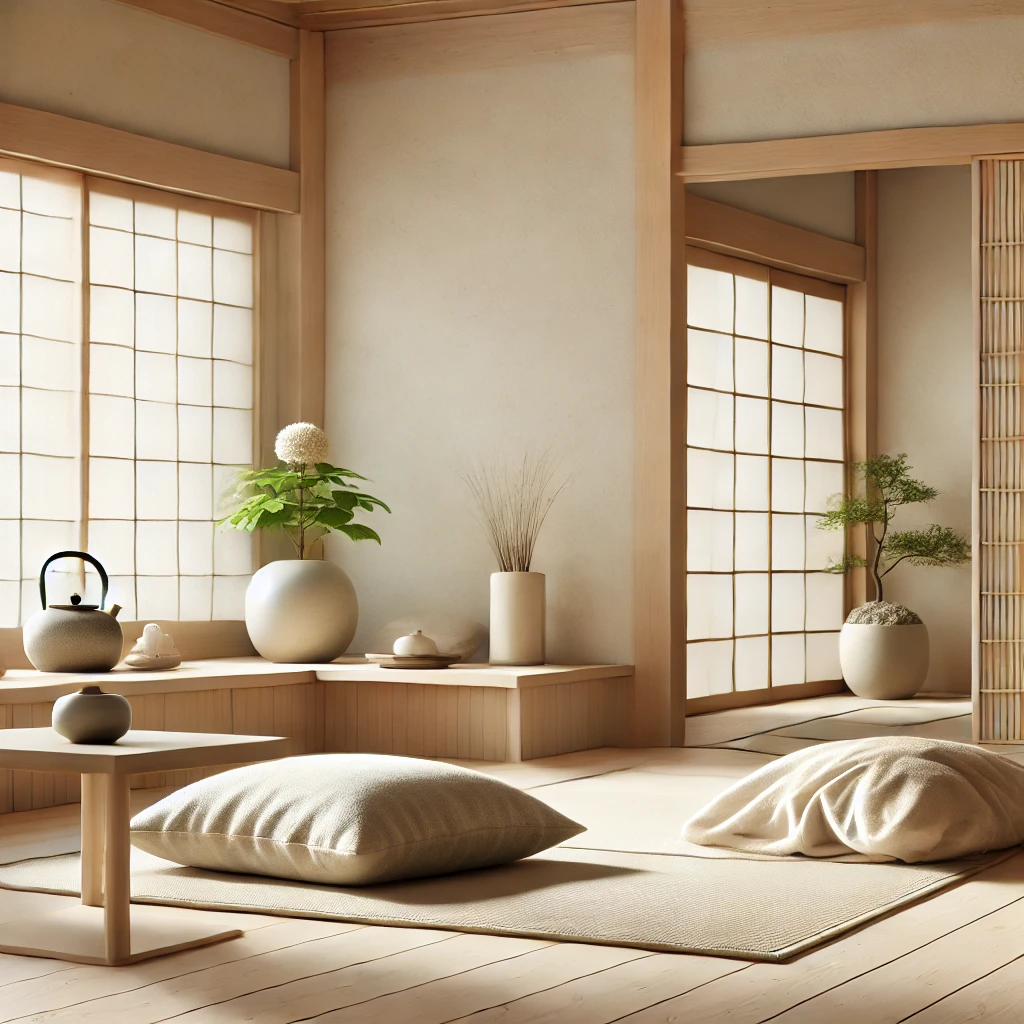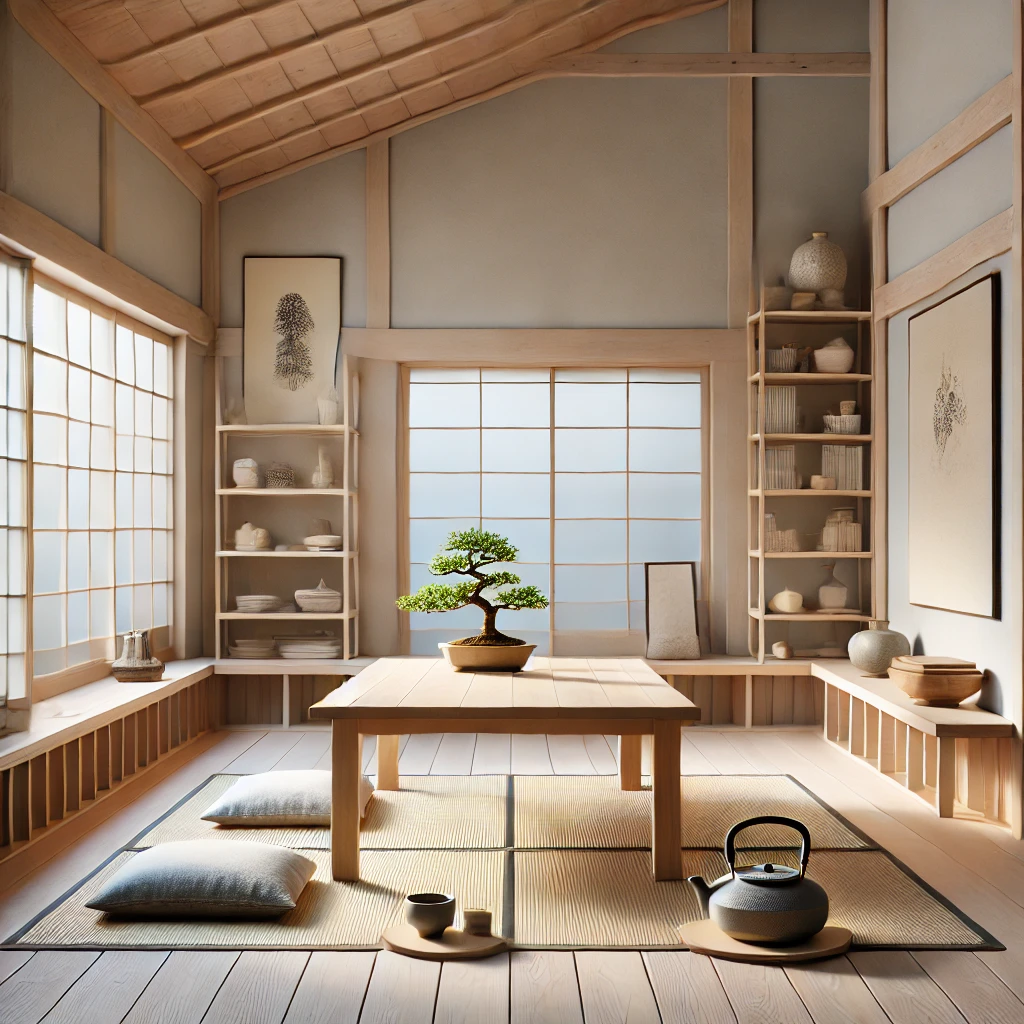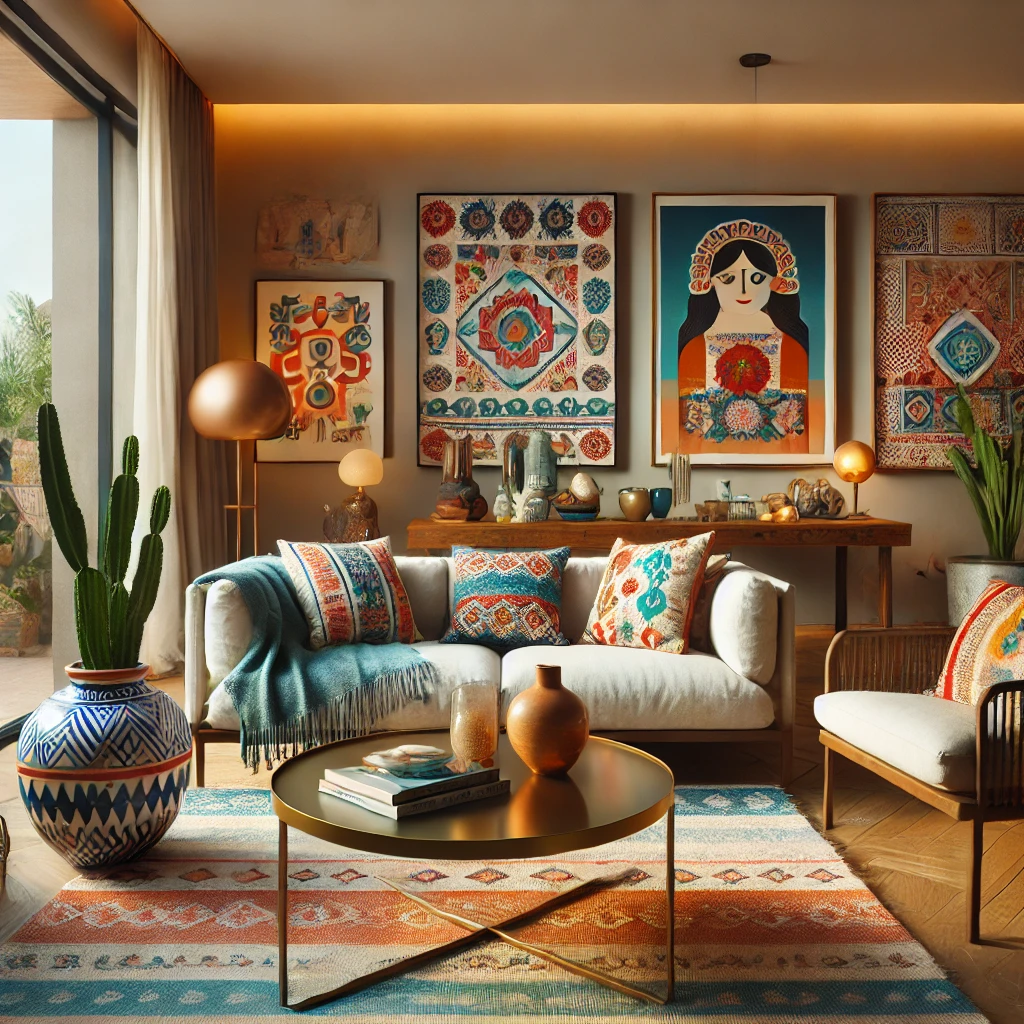Table of Contents
Understanding Japanese Minimalism
Japanese minimalism is not merely an aesthetic choice; it embodies a rich philosophical foundation steeped in cultural significance. At its core, minimalism in Japan emphasizes simplicity and functionality, promoting a lifestyle that prioritizes essential experiences over material possessions. This approach is deeply rooted in traditional Japanese values, which advocate for a harmonious relationship between individuals and their environment.
One of the defining principles of Japanese minimalism is the concept of ‘wabi-sabi,’ a worldview that finds beauty in imperfection and transience. Wabi-sabi appreciates the natural cycle of growth and decay, encouraging individuals to embrace the qualities of objects that may be considered flawed or incomplete. This idea resonates with the minimalist ethos, as it invites people to cultivate a sense of gratitude for the present moment, regardless of its imperfections.
Furthermore, minimalism in Japan is closely related to the notion of space and how it is utilized. Japanese homes are often designed to maximize functionality within limited square footage. This principle advocates for a clutter-free environment, allowing for greater focus on the things that truly matter. By removing distractions and prioritizing meaningful items, individuals can create a serene atmosphere that fosters mindfulness and reflection.
Minimalism in Japan also inspires various practices, such as decluttering and organizing, which are seen as pathways to achieving a more peaceful and purposeful existence. Engaging with minimalism encourages people to assess their possessions critically, leading to more intentional choices regarding what they keep in their lives. Thus, Japanese minimalism serves as a guide on how to live not only with less but with a deeper appreciation for the simplicity and essence of life.

The Benefits of Minimalism
Adopting a minimalist lifestyle offers a myriad of benefits that transcend mere aesthetics, deeply impacting mental well-being and overall quality of life. One of the most significant advantages of minimalism is the reduction of stress and anxiety. A cluttered environment can create feelings of overwhelm, whereas a space characterized by simplicity promotes a sense of calm and control. By surrounding oneself with only the essentials, individuals often find clarity not only in their surroundings but also in their thoughts, leading to enhanced focus and productivity.
Additionally, minimalism encourages a profound connection with one’s possessions. When individuals curate their belongings with care, they tend to develop a more meaningful relationship with each item. This conscious ownership fosters appreciation, reducing the desire for unnecessary acquisitions and material distractions. As a result, individuals may experience a greater sense of gratitude for what they have, thus enhancing their overall emotional well-being.
From a financial perspective, minimalism can yield significant savings. By adopting a mindset that values quality over quantity, individuals are less likely to engage in impulsive buying or accumulate items that serve little purpose. This approach not only reduces spending but also encourages more thoughtful investment in higher-quality goods that genuinely serve a function or bring joy. Furthermore, fewer possessions mean reduced costs related to storage, maintenance, and cleaning, ultimately leading to more financial freedom.
Lastly, minimalism cultivates deeper connections with people. When one is less preoccupied with material possessions, there is more mental space to nurture personal relationships. Without the constant distraction of clutter, individuals can invest their time and energy into experiences and connections that truly matter. Ultimately, embracing minimalism not only fosters a peaceful home environment but also enriches the quality of one’s life through meaningful interactions and mindful living.
Decluttering: The First Step
Embarking on a journey of minimalism requires an essential first step: decluttering one’s living space. The Japanese approach to decluttering, notably embodied in the ‘KonMari’ method developed by Marie Kondo, serves as an effective framework for this task. This method encourages individuals to evaluate their belongings based on the level of joy each item brings. To initiate this process, one can begin by gathering all items from a specific category, such as clothing or books, and placing them in a single location. This visual accumulation can often illuminate the extent of one’s possessions, prompting crucial considerations about what is genuinely necessary.
As you assess each item, ask yourself whether it sparks joy. If the answer is no, this serves as a strong indicator that the item may no longer add value to your life. The decision-making process can be emotionally taxing, as people often develop attachments to items, whether due to nostalgia or perceived utility. Acknowledge these feelings but also recognize that holding onto clutter can detract from your overall well-being. To facilitate this, create a set of guidelines that reflect your values and goals regarding your living space and possessions. For instance, you may decide to keep only items that align with your current lifestyle or aspirations.
Furthermore, a focus on maintaining a clutter-free home is paramount. After the initial decluttering, implement a routine for regular reassessment of new acquisitions to prevent the gradual return of excess. Consider adopting the ‘one in, one out’ rule, where for every new item brought into the home, an existing item must be released. This approach not only fosters mindfulness regarding consumption but also reinforces the principles of minimalism and sustainability. By effectively decluttering, you lay the foundational groundwork for a serene and organized living environment that reflects a simpler, more intentional lifestyle.
Designing a Minimalist Space
Creating a minimalist space that embodies Japanese aesthetics involves a thoughtful approach to design principles, colors, textures, and materials. Minimalism is rooted in simplicity and functionality, promoting a sense of tranquility that can significantly enhance the quality of life in one’s home. To begin, the choice of color palette plays a crucial role; natural tones, such as whites, soft grays, and muted earth tones, can create a serene environment. These hues not only reflect light but also connect the interior of a home with the calming essence of nature, which is essential to Japanese design.
Texture is another vital element to consider. Incorporating natural materials like wood, bamboo, and stone can instill warmth while maintaining a minimalist approach. These materials are often left in their raw state, showcasing their inherent beauty. For a touch of elegance, consider adding textiles such as cotton or linen in subtle patterns that complement the overall aesthetic. When combined thoughtfully, these textures create layers of visual interest without overwhelming the space.
In terms of layout, Japanese homes often emphasize open spaces. To achieve this effect, it is advisable to minimize clutter and prioritize open floor plans, allowing for fluid movement throughout the home. Furniture selection also warrants attention; opting for multi-functional pieces is aligned with minimalist principles, ensuring that each item serves a purpose while maintaining an airy atmosphere. Low-profile furniture can enhance the feeling of space while allowing for easy access and flow between areas.
Ultimately, embracing minimalist design not only facilitates a more organized living space but also encourages a mindful lifestyle. By harmonizing colors, textures, and functional furniture, one can create a home that echoes the principles of Japanese minimalism, fostering tranquility and clarity in daily life.
Incorporating Nature into Your Home
Embracing Japanese minimalism significantly involves establishing a connection with nature, which is considered essential for fostering tranquility and balance in living spaces. Natural elements are not only aesthetically pleasing but also promote mental well-being, making them a vital aspect of minimalist interiors. To achieve this harmonious blend, one should focus on integrating plants, natural light, and organic materials into their environment.
Firstly, introducing plants into your home can significantly enhance its ambiance. Houseplants like bamboo, bonsai trees, and peace lilies serve dual purposes: they improve air quality and add a touch of greenery reminiscent of serene outdoor landscapes. These plants can be strategically positioned in each room, serving as focal points while aligning with the minimalist principle of keeping clutter to a minimum. Selecting low-maintenance varieties can also minimize the care required, allowing one to enjoy their beauty without added stress.
Natural light is another crucial element in creating a serene atmosphere. Large windows or glass doors not only allow sunlight to flood the space but also provide a seamless transition between indoor and outdoor environments. This connection to the outdoors can be further emphasized by choosing sheer curtains that soften the light rather than obstruct it. Maximizing natural light can reduce the reliance on artificial lighting, contributing to a more peaceful home.
In addition to plants and light, incorporating organic materials into the home, such as wood, stone, and clay, can evoke a sense of nature. Furniture made from reclaimed wood or decor items crafted from natural stone can resonate with the Japanese principle of wabi-sabi, which appreciates the beauty of imperfection. Utilizing these materials thoughtfully ensures that the home remains uncluttered while reflecting a strong connection to the environment.
This harmonious incorporation of nature into minimalist living spaces not only enhances aesthetic appeal but also promotes a sense of peace and well-being, aligning perfectly with the foundations of Japanese minimalism.
Mindful Consumption and Waste Reduction
Embracing the principles of Japanese minimalism involves a significant shift in how we approach consumption. Mindful consumption emphasizes the importance of making intentional choices when acquiring new items, which ultimately leads to waste reduction and a more sustainable lifestyle. In a world often characterized by overconsumption, it is essential to question the necessity of our purchases, considering their impact on both our lives and the environment.
One of the first steps towards mindful consumption is to redefine our relationship with material possessions. This begins by prioritizing quality over quantity. When we choose durable, high-quality items, we not only ensure longevity but also reduce the frequency of replacements, which contributes to less waste. Furthermore, purchasing less frequently but with greater consideration can lead to a more meaningful selection of belongings that aligns with a minimalist philosophy.
In practice, discerning purchasing decisions can include various strategies. One effective approach is implementing a “30-day rule.” This entails waiting for a month before acquiring non-essential items. This waiting period provides adequate time to reflect on whether the item truly adds value to our lives or if it is simply a fleeting desire. Additionally, adopting a habit of decluttering can help in understanding what we truly need and love, further fostering an environment that promotes mindful consumption.
Moreover, embracing sustainable practices is integral to reducing waste. Opting for second-hand goods, supporting local artisans, or participating in swap events can significantly lessen the environmental impact of our consumption. By redirecting our focus toward mindfulness in consumption, we can not only simplify our homes but also contribute positively to the world around us.
Creating a Routine for Minimalism
Establishing a routine that supports a minimalist lifestyle is essential for maintaining order and simplicity in your home. A well-structured routine promotes habits that facilitate mindful living, allowing you to embrace minimalism seamlessly in your daily life. Start by integrating small daily practices that foster organization. Consider implementing a morning routine that includes a quick decluttering session. This could involve spending just ten minutes each day focusing on one area of your home, ensuring that items are in their designated places and unnecessary clutter is addressed promptly.
Another habit to consider is the evening ritual of preparing your space for the next day. This could include tidying up the kitchen, organizing your workspace, or selecting the outfit you will wear the following day. Such tasks not only create a sense of calm but also reinforce a minimalist aesthetic. Additionally, incorporating time for reflection is crucial. Dedicate a few moments each week to evaluate your belongings and habits. Ask yourself which items are essential to your life and which ones can be eliminated. This practice encourages mindfulness and assists in making conscious decisions about what truly adds value to your space.
Furthermore, consistency plays a vital role when establishing a routine for minimalism. It is beneficial to adhere to a weekly or monthly schedule to reassess your living environment. Consider implementing a “one-in, one-out” rule, where for every new item brought into your home, an existing item must be removed. This approach encourages thoughtful consumption and helps to maintain a clutter-free environment. Over time, these routines will not only streamline your home but also promote a more fulfilling, mindful lifestyle that aligns with the principles of Japanese minimalism.
Overcoming Challenges of Minimalism
Adopting a minimalist lifestyle can present various challenges that individuals must confront on their journey toward living with less. One of the most common obstacles is the emotional attachment that many people have to their possessions. These attachments can be deeply rooted, often stemming from memories associated with certain items. To address this challenge, it is vital to acknowledge these emotions while recognizing that memories do not reside solely in physical objects. Journaling or taking photographs of cherished items can provide an alternative way to preserve memories without needing to hold onto their physical counterparts.
Another challenge is the societal pressure to accumulate goods. In a culture that often equates success with material wealth, individuals may feel compelled to constantly acquire new items, even when they are trying to maintain a minimalist lifestyle. To combat this pressure, it is essential to cultivate a mindset that values experiences and relationships over material possessions. Engaging in conversations with like-minded individuals and participating in communities focused on minimalism can reinforce this mentality. By surrounding oneself with supportive voices, the desire to acquire can diminish in favor of appreciating what one already owns.
The fear of letting go can also hinder progress in embracing minimalism. This fear often manifests as anxiety when faced with decluttering. One effective strategy to mitigate this fear is to employ the “one in, one out” rule. This principle suggests that for every new item brought into the home, an old item must be removed. This approach fosters a sense of balance and encourages thoughtful consumption. Maintaining motivation can also be aided by setting specific goals, such as completing a decluttering session in a designated timeframe, ensuring a sense of accomplishment along the way. By employing these strategies, individuals can navigate the challenges of minimalism and continue their pursuit of a simpler, more fulfilling life.
Inspiration from Japanese Minimalist Homes
Japanese minimalist homes serve as a powerful source of inspiration for individuals seeking to simplify their living environments. These spaces are thoughtfully designed to maximize functionality while promoting a sense of tranquility and harmony. One notable figure in the minimalist movement is Muji, a Japanese retailer known for its simple, functional designs that epitomize minimalism. Their product lines demonstrate how everyday items can be created with a focus on utility and understated aesthetics.
Another influential design philosophy comes from the concept of “Wabi-Sabi,” which appreciates beauty in imperfection and the natural aging process. Homes that embody Wabi-Sabi often feature natural materials, muted color palettes, and well-curated decor that emphasizes open spaces. By implementing these principles, homeowners can create environments that foster calmness and connection to nature, as seen in many authentic Japanese residences.
Real-life examples of minimalist homes, such as the work of renowned architect Tadao Ando, showcase how design can integrate seamlessly with the surrounding landscape. Ando’s creations often feature concrete walls that create a peaceful shelter, while large windows connect the indoors to the outdoors. Such features enhance the sense of space and promote the idea of living with less by prioritizing essential elements over excess.

Additionally, visiting traditional Japanese homes in areas like Kyoto can provide further insights into minimalist living. These homes are characterized by sliding shoji screens, tatami mats, and open floor plans that encourage flexible use of space. Personal items are kept to a minimum, highlighting the importance of quality over quantity and the beauty of simplicity.
In summary, the inspiration drawn from Japanese minimalist homes encourages individuals to explore the principles of minimalism and apply them in their own spaces, fostering a lifestyle that values simplicity, functionality, and peace.





